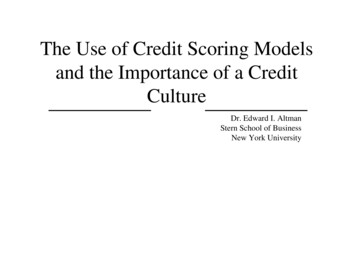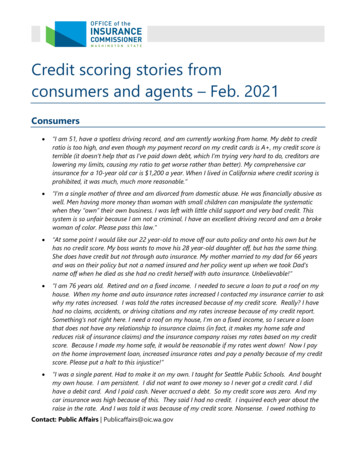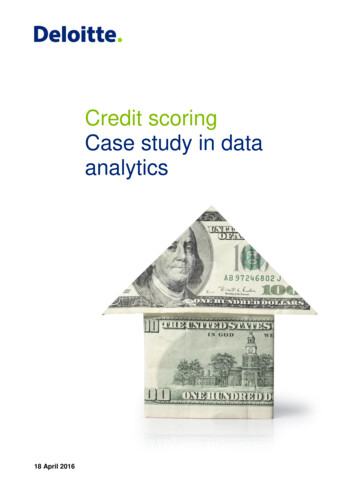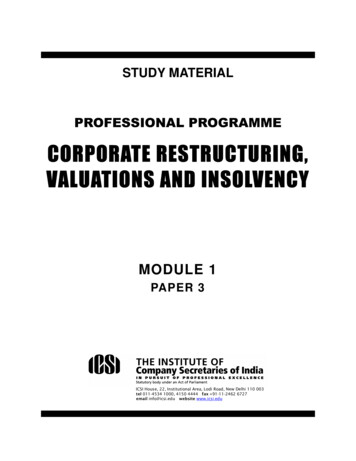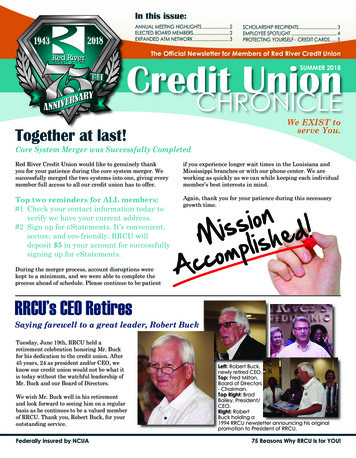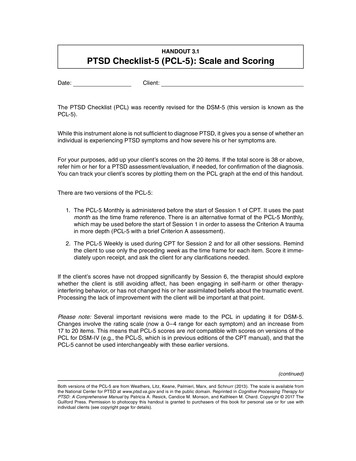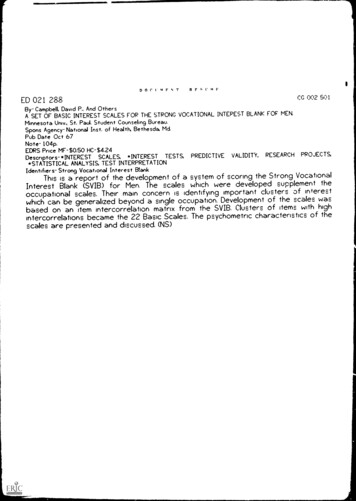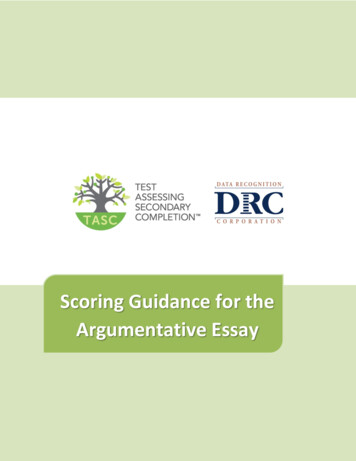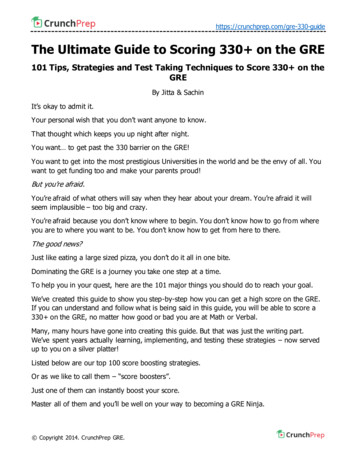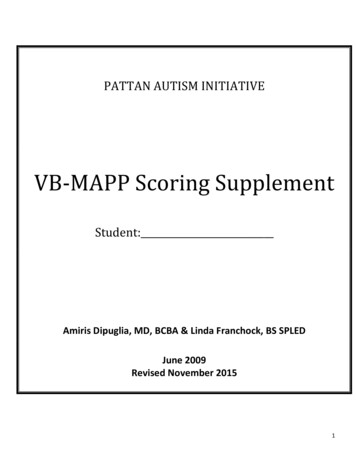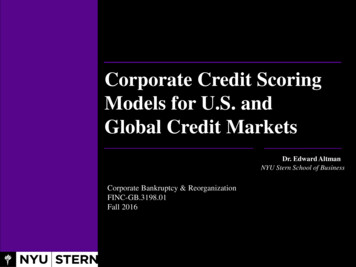
Transcription
Corporate Credit ScoringModels for U.S. andGlobal Credit MarketsDr. Edward AltmanNYU Stern School of BusinessCorporate Bankruptcy & ReorganizationFINC-GB.3198.01Fall 20161
Scoring Systems Qualitative (Subjective) Univariate (Accounting/Market Measures) Multivariate (Accounting/Market Measures)– Discriminant, Logit, Probit Models (Linear, Quadratic)– Non-Linear Models (e.g., RPA, NN) Discriminant and Logit Models in Use––––––Consumer Models - Fair IsaacsZ-Score (5) - ManufacturingZETA Score (7) - IndustrialsPrivate Firm Models (eg. Risk Calc (Moody’s), Z” Score)EM Score (4) - Emerging Markets, IndustrialOther - Bank Specialized Systems2
Scoring Systems(continued) Artificial Intelligence Systems– Expert Systems– Neural Networks (eg. Credit Model (S&P), CBI (Italy)) Option/Contingent Claims Models– Risk of Ruin– KMV Credit Monitor Model Blended Ratio/Market Value Models– Moody’s Risk Cal– Bond Score (Credit Sights)– Z-Score (Market Value Model) Z-Metrics (MSCI)– Blended and Macro Approach3
Major Agencies Bond Rating Ba2Ba3B1B2B3Caa1CaaCaa3CaCS&P/FitchAAAAA AAAAA AABBB Investment BBBGradeBBBHigh Yield BB ("Junk")BBBBB BBCCC CCCCCCCCCD4
Size of the US High-Yield Bond Market1978 – 2016 (Mid-year US billions) 1,800 1,656 1,600 1,400 (Billions) 1,200 1,000 800 600 400 0152016 200Source: NYU Salomon Center estimates using Credit Suisse, S&P and Citi data.5
Key Industrial Financial Ratios(U.S. Industrial Long-term Debt)Medians of Three- Year (2009-2011) AveragesAAAAAABBBBBBEBITDA margin (%)27.927.620.419.717.616.6Return on Capital (%)30.623.620.713.210.97.82.7EBIT Interest Coverage(x)33.414.211.65.93.01.30.4EBITDA Interest Coverage (x)38.119.615.38.24.82.31.1Funds from Operations/Total Debt (%)252.664.752.633.724.911.72.5Free Operating Cash Flow/Total Debt (%)208.251.335.719.011.13.9(3.6)Disc. Cash Flow/Debt (%)142.832.026.113.98.83.1Total Debt/EBITDA (x)0.41.21.52.33.25.58.6Total Debt/Total Debt Equity (%)14.729.233.843.552.275.298.941493227260287No. of CompaniesCCC** 2005-2007Source: Standard & Poor’s, CreditStats: 2011 Industrial Comparative Ratio Analysis, Long-Term Debt –US (RatingsDirect, August 2012).6
Key Industrial Financial Ratios(Europe, Middle East & Africa Industrial Long-term Debt)Medians of Three- Year (2008-2010) AveragesAAABBBBBBEBITDA margin (%)24.916.615.517.616.3Return on Capital (%)20.015.311.29.36.7EBIT Interest Coverage(x)15.77.03.93.11.0EBITDA Interest Coverage (x)18.59.55.74.62.0Funds from Operations/Total Debt (%)83.445.732.322.710.5Free Operating Cash Flow/Total Debt (%)57.823.216.07.11.3Disc. Cash Flow/Debt (%)30.512.58.03.40.8Total Debt/EBITDA (x)0.91.62.63.25.8Total Debt/Total Debt Equity (%)25.733.844.451.975.88551045855No. of CompaniesSource: Standard & Poor’s, CreditStats: 2010 Adjusted Key US & European Industrial and UtilityFinancial Ratios (RatingsDirect, August 2011).7
Problems With Traditional FinancialRatio Analysis1 Univariate Technique1-at-a-time2 No “Bottom Line”3 Subjective Weightings4 Ambiguous5 Misleading8
Forecasting Distress With Discriminant AnalysisLinear FormZ a1x1 a2x2 a3x3 anxnZ Discriminant Score (Z Score)a1an Discriminant Coefficients (Weights)x1xn Discriminant Variables (e.g. Ratios)ExamplexxxEBITTAxxxxxxxxxxxxxxxx xxxx xx xx xx xxxxx xx x xxEQUITY/DEBT9
Z-Score Component Definitions and WeightingsVariableX1DefinitionWeighting FactorWorking Capital1.2Total AssetsX2Retained Earnings1.4Total AssetsX3EBIT3.3Total AssetsX4Market Value of Equity0.6Book Value of Total LiabilitiesX5SalesTotal Assets1.010
Z Score Bankruptcy ModelZ .012X1 .014X2 .033X3 .006X4 .999X5e.g. 20.0%Z 1.2X1 1.4X2 3.3X3 .6X4 .999X5e.g. 0.20X1 Current Assets - Current LiabilitiesX4 Market Value of EquityTotal AssetsX2 Retained EarningsTotal AssetsTotal LiabilitiesX5 Sales( # of TimesTotal Assetse.g. 2.0x)X3 Earnings Before Interest and TaxesTotal Assets11
Zones of Discrimination:Original Z - Score Model (1968)Z 2.99 - “Safe” Zone1.8 Z 2.99 - “Grey” ZoneZ 1.80 - “Distress” Zone12
Time Series Impact On CorporateZ-Scores Credit Risk Migration- Greater Use of Leverage- Impact of HY Bond & LL Markets- Global Competition- More and Larger Bankruptcies Increased Type II Error13
Estimating Probability of Default (PD) andProbability of Loss Given Defaults (LGD)Method #1 Credit scores on new or existing debt Bond rating equivalents on new issues (Mortality) orexisting issues (Rating Agency Cumulative Defaults) Utilizing mortality or cumulative default rates to estimatemarginal and cumulative defaults Estimating Default Recoveries and Probability of LossorMethod #2 Credit scores on new or existing debt Direct estimation of the probability of default Based on PDs, assign a rating14
Median Z-Score by S&P Bond Rating for U.S.Manufacturing Firms: 1992 - 2013Rating2013 (No.)2004-20101996-20011992-1995AAA/AA4.13 (15)4.186.20*4.80*A4.00 (64)3.714.223.87BBB3.01 (131)3.263.742.75BB2.69 (119)2.482.812.25B1.66 (80)1.741.801.87CCC/CC0.23 (3)0.460.330.40D0.01 (33)-0.04-0.200.05*AAA Only.Sources: Compustat Database, mainly S&P 500 firms, compilation by NYU Salomon Center, Stern School of Business.15
Marginal and Cumulative Mortality Rate Actuarial ApproachMMR(r,t)total value of defaulting debt from rating (r) in year (t)total value of the population at the start of the year (t) Marginal Mortality RateMMROne can measure the cumulative mortality rate (CMR) over a specifictime period (1,2, , T years) by subtracting the product of the survivingpopulations of each of the previous years from one (1.0), that is,CMR(r,t) 1 - Π SR(r,t) ,t 1 Nr AAA CCChere(t),CMR (r,t) Cumulative Mortality Rate of (r) inSR (r,t) Survival Rate in (r,t) , 1 - MMR (r,t)16
Mortality Rate Concept(Illustrative Calculation)For BB Rated IssuesSecurityNo.IssuedAmountYear 1DefaultCallSFYear mountStart ofPeriod1,5001,325- 34012345678910-175- Year 1Year 2MarginalMortalityRate50/1,500 3.3%100/1,325 7.5%Cumulative Rate3.3%1 - (SR1 x SR2 ) CMR21 - (96.7% x 92.5%) 10.55%985NE No longer in existenceSF Sinking fund17
Mortality Rates by Original RatingAll Rated Corporate Bonds*1971-2015Years After Issuance*Rated by S&P at IssuanceBased on 2,903 issues18Source: Standard & Poor's (New York) and Author's Compilation
Mortality Losses by Original RatingAll Rated Corporate Bonds*1971-2015Years After Issuance*Rated by S&P at IssuanceBased on 2,481 issuesSource: Standard & Poor's (New York) and Author's Compilation19
Classification & Prediction AccuracyZ Score (1968) Failure Model*1969-19751976-19951997-1999Year PriorTo FailureOriginalSample (33)HoldoutSample (25)PredictiveSample (86)PredictiveSample (110)PredictiveSample (120)194% (88%)96% (72%)82% (75%)85% (78%)94% g 2.67 as cutoff score (1.81 cutoff accuracy in parenthesis)20
Z Score Trend - LTV Corp.Z Score3.532.992.51.8 21.510.50-0.5-1-1.5Safe ZoneBBB-BB Grey ZoneDistress ZoneB-BCCC CCC D1980198119821983Year198419851986BankruptJuly ‘8621
Z ScoreInternational Harvester (Navistar)Z Score (1974 – 2001)3.532.521.510.50-0.5Safe ZoneGrey ZoneDistress Zone'74 '76 '78 '80 '82 '84 '86 '88 '90 '92 '94 '96 '98 '00Year22
Chrysler CorporationZ Score (1976 – 3Q 1998*)4Safe Zone3.5Z Score3Operating Co.2.52Grey Zone1.5Consolidated Co.10.50Gov’t Loan Third quarter figures for 1998 are annualized23
Eastman Kodak: Z-Score AnalysisDecember 2003 – December 2011 (Biennial)2.50Z-Score2.00BBBCCC1.501.00Ch. 11 712/31/200912/31/2011Z-Score24
Z ScoreIBM CorporationZ Score (1980 – 2001)65.554.543.532.521.510.50Operating Co.Safe ZoneJuly 1993:Downgrade AA- to AConsolidated Co.Grey ZoneBBBBBB1/93: DowngradeAAA to AA-1980 1982 1984 1986 1988 1990 1992 1994 1996 1998 2000Year25
U.S. Automotive Industry: Z, Z"-Scores and Bond RatingEquivalents (BRE) - Ford & GM: Z and Z”-Score 12/31/080.85CCC(0.63)D12/31/071.15B-0.77CCC 12/31/060.95CCC 1.12B-12/31/051.25B-0.96CCC Z”-ScoresBREZ”-ScoresBRE09/30/135.61BB-4.56B 12/31/125.59BB-4.54B 12/31/116.29BB 5.04B 12/31/105.86BB-4.60B 12/31/095.84BB-2.72CCC 12/31/084.71B -12/31/055.74BB-6.59BBB Note: Consolidated Annual Results. Data Source: Bloomberg., Edgar26
Z-Score Model Applied to Ford (Consolidated Data):Bond Rating Equivalents and Scores from 2005 – 2013 (9/30)Z- Score: Ford Motor Co.1.80BB1.601.40BB-Z-ScoreCCC 0712/31/2009Z-Score12/31/20119/30/201327
Z-Score Model Applied to GM (Consolidated Data):Bond Rating Equivalents and Scores from 2005 – 2015Z- Score: General Motors Co.2.00B1.50BFull Emergencefrom Bankruptcy3/31/11CCC 0.50BBBUpgrade to BBBby ce, New Co. Only, fromBankruptcy, -060.00Dec-05Z-Score1.00CCC B-BCh. 11 Filing6/01/09DZ-Score28
Z’ ScorePrivate Firm ModelZ’ .717X1 .847X2 3.107X3 .420X4 .998X5X1 Current Assets - Current LiabilitiesTotal AssetsX2 Retained EarningsTotal AssetsX3 Earnings Before Interest and TaxesTotal AssetsX4 Book Value of EquityTotal LiabilitiesX5 SalesZ’ 2.90 - “Safe” Zone1.23 Z’ 2.90 - “Grey” ZoneZ’ 1.23 - “Distress” ZoneTotal Assets29
Z” Score Model for Manufacturers, Non-ManufacturerIndustrials; Developed and Emerging Market CreditsZ” 3.25 6.56X1 3.26X2 6.72X3 1.05X4X1 Current Assets - Current LiabilitiesTotal AssetsX2 Retained EarningsTotal AssetsX3 Earnings Before Interest and TaxesTotal AssetsX4 Book Value of EquityTotal LiabilitiesZ” 5.85 - “Safe” Zone4.35 Z” 5.85 - “Grey” ZoneZ” 4.35 - “Distress” Zone30
Classification & Prediction Accuracy (Type I) Z”-ScoreBankruptcy Model* (Based on the Original Sample and a Sample ofRecent Bankruptcies (2011-2014))No. of MonthsPrior toBankruptcy FilingOriginal Sample(33)Holdout Sample(25)2011-2014Predictive Sample (71)694%96%93%1872%80%87%30--67%*E. Altman and J. Hartzell, “Emerging Market Corporate Bonds – A Scoring System”, Salomon BrothersCorporate Bond Research, May 15, 1995, Summarized in E. Altman and E. Hotchkiss, Corporate FinancialDistress and Bankruptcy, 3rd Edition, John Wiley & Sons, 2006.31
Z”-Score Analysis of A Sample of Recently BankruptPublicly Held, Non-financial Companies(2011-2014)Z”-Scores and CutoffsZ” (t)*Z” (t-1)*Z” �� 4.35 (Distress Zone)66/7162/7146/69Type I Z” 5.85 (Safe Zone)Type II Accuracy* On average, 5.6 months prior to bankruptcy at (t), 17.6 months at (t-1) and 29.6 months at (t-2).Source: Altman NYU Salomon Center Bankruptcy Database, Capital I.Q, Altman & Hotchkiss (2006).32
US Bond Rating Equivalents Based on Z”-Score ModelZ” 3.25 6.56X1 3.26X2 6.72X3 1.05X4aSampleRatingMedian 1996 Z”-ScoreaMedian 2006 Z”-ScoreaMedian 2013 Z”-ScoreaAAA/AA 8.15 (8)7.51 (14)8.80 (15)AA/AA-7.16 (33)7.78 (20)8.40 (17)A 6.85 (24)7.76 (26)8.22 (23)A6.65 (42)7.53 (61)6.94 (48)A-6.40 (38)7.10 (65)6.12 (52)BBB 6.25 (38)6.47 (74)5.80 (70)BBB5.85 (59)6.41 (99)5.75 (127)BBB-5.65 (52)6.36 (76)5.70 (96)BB 5.25 (34)6.25 (68)5.65 (71)BB4.95 (25)6.17 (114)5.52 (100)BB-4.75 (65)5.65 (173)5.07 (121)B 4.50 (78)5.05 (164)4.81 (93)B4.15 (115)4.29 (139)4.03 (100)B-3.75 (95)3.68 (62)3.74 (37)CCC 3.20 (23)2.98 (16)2.84 (13)CCC2.50 (10)2.20 (8)2.57(3)CCC-1.75 (6)1.62 (-)b1.72 (-)bCC/D0 (14)0.84 (120)0.05 (94)cSize in Parantheses. bInterpolated between CCC and CC/D. cBased on 94 Chapter 11 bankruptcy filings, 2010-2013.Sources: Compustat, Company Filings and S&P.33
Classification & Prediction Accuracy (Type I)Z”-Score Bankruptcy Model*No. of MonthsPrior toBankruptcy FilingOriginal Sample(33)Holdout Sample(25)2011-2014Predictive Sample (69)694%96%93%1872%80%87%*E. Altman and J. Hartzell, “Emerging Market Corporate Bonds – A Scoring System”, Salomon BrothersCorporate Bond Research, May 15, 1995, Summarized in E. Altman and E. Hotchkiss, CorporateFinancial Distress and Bankruptcy, 3rd Edition, John Wiley & Sons, 2006.34
American Airlines: Z Score & Z” Score AnalysisDecember 2003 – June 12/31/1003/31/1106/30/11Z''-Score35
Enron Credit Risk : A. Saunders and L. Allen, Credit Risk Measurement; J. Wiley, 200236
DAF Corporation Z Scores(Dutch Company Bankruptcy 1993)2.522.151.75Z 7
AN EMERGING MARKETCORPORATE MODEL
An Emerging Market Credit Scoring System Step 1- Calculate the EM Score and its Bond Rating Equivalent (BRE) com
– KMV Credit Monitor Model Blended Ratio/Market Value Models – Moody’s Risk Cal – Bond Score (Credit Sights) – Z-Score (Market Value Model) Z-Metrics (MSCI) – Blended and Macro Approach. 4. Major Agencies Bond Rating Categories. Moody's S&P/Fitch Aaa AAA Aa1 AA Aa2 AA Aa3 AA-A1 A A2 A A3 A-Baa1 BBB Baa2 Investment BBB Baa3 Grade BBB-Ba1 High Yield BB Ba2 ("Junk") BB
